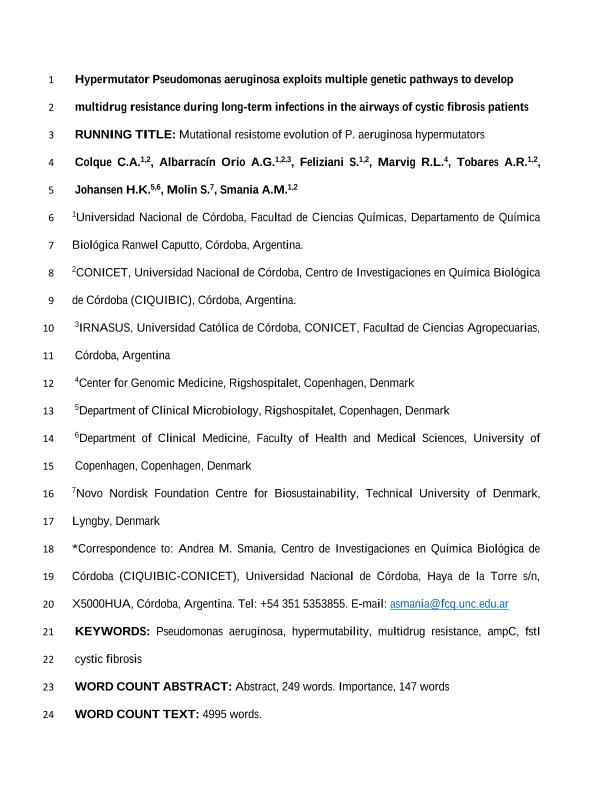Artículo
Hypermutator pseudomonas aeruginosa exploits multiple genetic pathways to develop multidrug resistance during long-term infections in the airways of cystic fibrosis patients
Colque, Claudia Antonella ; Albarracín Orio, Andrea Georgina
; Albarracín Orio, Andrea Georgina ; Feliziani, S.; Marvig, R. L.; Tobares, Romina Alín
; Feliziani, S.; Marvig, R. L.; Tobares, Romina Alín ; Johansen, H.K.; Molin, S.; Smania, Andrea
; Johansen, H.K.; Molin, S.; Smania, Andrea
 ; Albarracín Orio, Andrea Georgina
; Albarracín Orio, Andrea Georgina ; Feliziani, S.; Marvig, R. L.; Tobares, Romina Alín
; Feliziani, S.; Marvig, R. L.; Tobares, Romina Alín ; Johansen, H.K.; Molin, S.; Smania, Andrea
; Johansen, H.K.; Molin, S.; Smania, Andrea
Fecha de publicación:
10/2019
Editorial:
American Society for Microbiology
Revista:
Antimicrobial Agents and Chemotherapy
ISSN:
0066-4804
e-ISSN:
1098-6596
Idioma:
Inglés
Tipo de recurso:
Artículo publicado
Clasificación temática:
Resumen
Pseudomonas aeruginosa exploits intrinsic and acquired resistance mechanisms to resist almost every antibiotic used in chemotherapy. Antimicrobial resistance in P. aeruginosa isolates recovered from cystic fibrosis (CF) patients is further enhanced by the occurrence of hypermutator strains, a hallmark of chronic infections in CF patients. However, the within-patient genetic diversity of P. aeruginosa populations related to antibiotic resistance remains unexplored. Here, we show the evolution of the mutational resistome profile of a P. aeruginosa hypermutator lineage by performing longitudinal and transversal analyses of isolates collected from a CF patient throughout 20 years of chronic infection. Our results show the accumulation of thousands of mutations, with an overall evolutionary history characterized by purifying selection. However, mutations in antibiotic resistance genes appear to have been positively selected, driven by antibiotic treatment. Antibiotic resistance increased as infection progressed toward the establishment of a population constituted by genotypically diversified coexisting sublineages, all of which converged to multidrug resistance. These sublineages emerged by parallel evolution through distinct evolutionary pathways, which affected genes of the same functional categories. Interestingly, ampC and ftsI, encoding the β-lactamase and penicillin-binding protein 3, respectively, were found to be among the most frequently mutated genes. In fact, both genes were targeted by multiple independent mutational events, which led to a wide diversity of coexisting alleles underlying β-lactam resistance. Our findings indicate that hypermutators, apart from boosting antibiotic resistance evolution by simultaneously targeting several genes, favor the emergence of adaptive innovative alleles by clustering beneficial/compensatory mutations in the same gene, hence expanding P. aeruginosa strategies for persistence.
Archivos asociados
Licencia
Identificadores
Colecciones
Articulos(CIQUIBIC)
Articulos de CENTRO DE INVEST.EN QCA.BIOL.DE CORDOBA (P)
Articulos de CENTRO DE INVEST.EN QCA.BIOL.DE CORDOBA (P)
Citación
Colque, Claudia Antonella; Albarracín Orio, Andrea Georgina; Feliziani, S.; Marvig, R. L.; Tobares, Romina Alín; et al.; Hypermutator pseudomonas aeruginosa exploits multiple genetic pathways to develop multidrug resistance during long-term infections in the airways of cystic fibrosis patients; American Society for Microbiology; Antimicrobial Agents and Chemotherapy; 64; 5; 10-2019; 1-38
Compartir
Altmétricas



